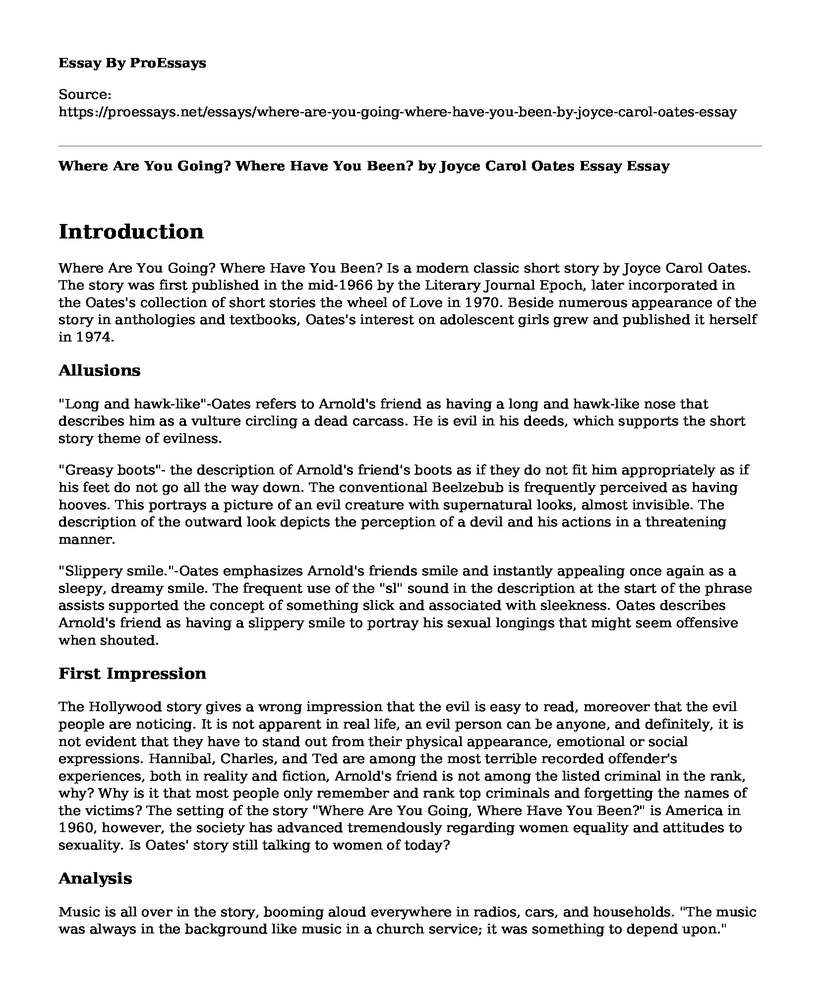Introduction
Where Are You Going? Where Have You Been? Is a modern classic short story by Joyce Carol Oates. The story was first published in the mid-1966 by the Literary Journal Epoch, later incorporated in the Oates's collection of short stories the wheel of Love in 1970. Beside numerous appearance of the story in anthologies and textbooks, Oates's interest on adolescent girls grew and published it herself in 1974.
Allusions
"Long and hawk-like"-Oates refers to Arnold's friend as having a long and hawk-like nose that describes him as a vulture circling a dead carcass. He is evil in his deeds, which supports the short story theme of evilness.
"Greasy boots"- the description of Arnold's friend's boots as if they do not fit him appropriately as if his feet do not go all the way down. The conventional Beelzebub is frequently perceived as having hooves. This portrays a picture of an evil creature with supernatural looks, almost invisible. The description of the outward look depicts the perception of a devil and his actions in a threatening manner.
"Slippery smile."-Oates emphasizes Arnold's friends smile and instantly appealing once again as a sleepy, dreamy smile. The frequent use of the "sl" sound in the description at the start of the phrase assists supported the concept of something slick and associated with sleekness. Oates describes Arnold's friend as having a slippery smile to portray his sexual longings that might seem offensive when shouted.
First Impression
The Hollywood story gives a wrong impression that the evil is easy to read, moreover that the evil people are noticing. It is not apparent in real life, an evil person can be anyone, and definitely, it is not evident that they have to stand out from their physical appearance, emotional or social expressions. Hannibal, Charles, and Ted are among the most terrible recorded offender's experiences, both in reality and fiction, Arnold's friend is not among the listed criminal in the rank, why? Why is it that most people only remember and rank top criminals and forgetting the names of the victims? The setting of the story "Where Are You Going, Where Have You Been?" is America in 1960, however, the society has advanced tremendously regarding women equality and attitudes to sexuality. Is Oates' story still talking to women of today?
Analysis
Music is all over in the story, booming aloud everywhere in radios, cars, and households. "The music was always in the background like music in a church service; it was something to depend upon." (Oates, 2002). Music is omnipresent that it seems to affect how characters are thinking, feelings and actions. According to Connie, music is closely related to her senses. In the mid-sixties, the American youth culture was changing, and the idea of free love had begun to penetrate the cities characterized by louder and wilder music than before.
Connection
In similar ways, Connie's behavior in "Where Are You Going, Where Have You Been" of checking herself in a reflection mirror echoes the renaissance folktales of "Death and the Maiden." The victims of the tales frequently depicted looking into mirrors, flattering their beauty, which is similar to Connie. A long, smooth hair is regarded as a significant sign of pride in the Death and the Maiden culture. Likewise, Connie had long golden hair that signified her magnificence and vanity, affords to skip a family event to make up her hair (Oates, 2002).
Evaluation
I liked the straightforward imaginative writing style of the Oates, which is journalistic in the sense that there are fewer instances of extreme stylistic additions or tedious sentence structures. When she spares the writing styles, it enables the story to stand out clearly in a manner that portrays a mysterious meaning. Normal things including sunglasses worn by Arnold have a significant emotional impact in the tale. Moreover, common phrases such the number of times your parents have inquired where you are going or where you have been making the story substantial, several current problems regarding life, morals, and identity. The American culture is irrefutably guilty of emphasizing more on the outward appearance that in turn exposes the American people to exploitation and misunderstanding.
References
Oates, J. C. (2002). Where are you going, where have you been? New Brunswick, NJ: Rutgers Univ. Press.
Cite this page
Where Are You Going? Where Have You Been? by Joyce Carol Oates Essay. (2022, Aug 05). Retrieved from https://proessays.net/essays/where-are-you-going-where-have-you-been-by-joyce-carol-oates-essay
If you are the original author of this essay and no longer wish to have it published on the ProEssays website, please click below to request its removal:
- Heinrich Heine's Poems Essay Example
- "The Yellow Wallpaper": Suppression of Women in 19th Century and Escape
- "Love in L.A." Clash of Culture Theme Analysis Essay
- Comparison of Dante's "Divine Comedy" and Chaucer's "Canterbury Tales"
- Compare and Contrast Essay on the Use of Imagery and Metaphors in Poetry
- Essay Example on Humor: Transgression of Taboos & Surprising Deviations
- Essay Sample on A Clean, Well-Lighted Place: Hemingway's Autobiographical Criticism







